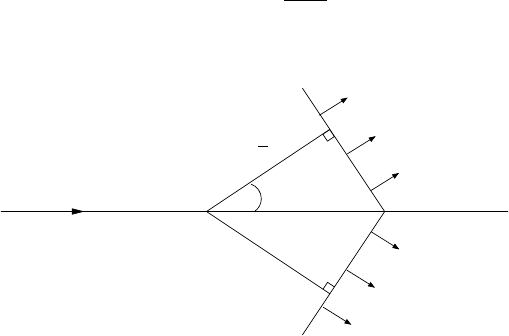Leroy C., Rancoita P.-G. Principles Of Radiation Interaction In Matter And Detection
Подождите немного. Документ загружается.


January 9, 2009 10:21 World Scientific Book - 9.75in x 6.5in ws-bo ok975x65˙n˙2nd˙Ed
420 Principles of Radiation Interaction in Matter and Detection
There are several parameters characterizing scintillators. The scintillation ef-
ficiency, R
s
, is the ratio of the average number of emitted photons hN
ph
i to the
energy E
i
of the incident radiation absorbed by the scintillator:
R
s
=
hN
ph
i
E
i
. (5.1)
The scintillation yield, R
r
, is the ratio of the total energy of the emitted light to
E
i
. It is obtained by multiplying the right-hand side of Eq. (5.1) by the energy, hν,
of the emitted photons:
R
r
= R
s
hν. (5.2)
The photoelectric efficiency, R
pe
, of the scintillating material is often quoted in
medical physics for absorption of X- and γ-rays. This quantity is the ratio, R
pe
, of
the number of the incident X- and γ-rays that have deposited all their energy in
the material, N
ph,absorbed
, to the total number of photons that have been detected,
N
ph,detected
:
R
pe
=
N
ph,absorbed
N
ph,detected
. (5.3)
From its definition, R
pe
features the importance of the absorption power of radiation
by the scintillating material. It depends on the incident energy and geometrical size
of the scintillating material struck by the radiation.
The scintillation spectrum has to be matched to the spectral sensitivity of the
photosensitive device coupled to the scintillator. The wavelength corresponding to
the maximum emission of light has to fall within the range of the spectral sensitivity
of the photocathode of the photomultiplier (photosensitive device).
As will be seen below, the time response of the scintillator material is controlled
by decay time constants.
The growth in time of the scintillation pulse is characterized by a fast rise time,
followed by a decay which has two components: a fast exponential decay and a
slower decay. The decay time constant of the fast component determines the time
response of the scintillating material. This parameter guides the choice of the type
of scintillating material for specific applications.
The scintillator material must be transparent to its own scintillation light. It
turns out that the emission wavelength is, in general, longer than the absorption
wavelength (Stokes’s shift).
5.1.1 Organic Scintillators
Organic scintillators are aromatic hydrocarbon compounds containing a benzenic
cycle. In organic scintillators, the mechanism of light emission is a molecular ef-
fect. It proceeds through excitation of molecular levels in a primary fluorescent
material, which emits bands of ultraviolet (UV) light during de-excitation. This
UV light is absorbed in most organic materials with an absorption length of a few

January 9, 2009 10:21 World Scientific Book - 9.75in x 6.5in ws-bo ok975x65˙n˙2nd˙Ed
Scintillating Media and Scintillator Detectors 421
mm. The extraction of a light signal becomes possible only by introducing a second
fluorescent material in which the UV light is converted into visible light (wavelength
shifter). This second substance is chosen in such a way that its absorption spec-
trum is matched to the emission spectrum of the primary fluor, and its emission
spectrum, adapted to the spectral dependence of the photocathode quantum effi-
ciency. These two active components of a scintillator are either dissolved in suitable
organic liquids or mixed with the monomer of a material capable of polymerization.
Plastic scintillators can be produced in a variety of shapes adapted to the ap-
plication needs. As an indication, most frequently used are rectangular plates with
thicknesses from 0.1 up to 30.0 mm and area from a few mm
2
up to several m
2
. They
are of current use in a wide range of applications such as b eam counters and active
medium of sampling calorimeters. In sampling calorimeters (discussed in Sect. 9.2)
using scintillators as active medium, the incoming particle energy is measured in a
numb er of plastic scintillating layers interspersed with layers of absorbing material
(metal), the latter speeding up the cascade process. A schematic description of a
sampling calorimeter is shown in Fig. 9.1 in the chapter on Principles of Parti-
cle Energy Determination. The scintillation light is coupled from the scintillator
layers to the photosensitive device via light guides. However, in most cases, such
arrangement is not practical, since it does not favor good transverse and longi-
tudinal segmentations and create large gaps in which energy may be lost. In the
case of fixed target experiments with large solid angle coverage or colliding beam
experiment, the scintillating light is transported to the photosensitive device via
wavelength shifter (WLS) material (see Sect. 5.3 on wavelength shifter).
For organic scintillators, the relation between the emitted light and the energy
deposited by an ionizing particle is not linear. The scintillator response dep ends also
on the type of particle and its specific ionization. The relation between emitted light
and energy deposited by ionizing particles is expressed by Birks’ Law [Birks (1951,
1964)]. This law assumes that the response of organic scintillator is linear. Possible
deviation from this linearity is explained by quenching interactions between excited
molecule created along the path of the ionizing particle, absorbing energy which
causes a reduction of the scintillation efficiency. Birks’ law correlates the amount of
emitted light per unit of length, the differential light output dL/dx, to the stopping
power of the ionizing particle dE/dx, namely
dL
dx
=
µ
R
s
dE
dx
¶Áµ
1 + kB
dE
dx
¶
, (5.4)
where R
s
is the scintillation efficiency [see Eq. (5.1)], B is the Birks constant of the
medium and k is the quenching parameter. Here kB acts as a saturation constant
achieving a value ∼ 0.01–0.02 g/cm
2
MeV for a scintillator. In practice, kB is handled
as an adjustable parameter to fit experimental data for a specific scintillator with
R
s
giving the absolute normalization. The total amount of light, L, produced by a
particle of energy, E, in a scintillator is obtained by integration of Eq. (5.4).

January 9, 2009 10:21 World Scientific Book - 9.75in x 6.5in ws-bo ok975x65˙n˙2nd˙Ed
422 Principles of Radiation Interaction in Matter and Detection
For small dE/dx (e.g. for fast electrons), Eq. (5.4) reduces to
dL
dx
≈ R
s
dE
dx
, (5.5)
while for large dE/dx (e.g. for α-particles), Eq. (5.4) becomes:
dL
dx
≈
R
s
kB
. (5.6)
The integration of Eq. (5.6) over x gives the amount of light as a function of the
range, R(E), of the particle with energy E
L(E) ∼
R
s
kB
R(E). (5.7)
Practically, kB can be determined from the ratio between Eq. (5.5) and Eq. (5.6).
Organic scintillators can also be liquids. In a liquid scintillator, an organic crys-
tal (solute) is dissolved in a solvent with typical concentrations of ≈ 3 g of solute per
liter of solvent. The ionization energy absorbed by the solvent is transferred to the
solute which is responsible for fluorescence. This transfer can be achieved as light
emission by the solvent, absorption by the solute and re-emission at larger wave-
length. The scintillation efficiency increases with the solute concentration [Schram
(1963)]. Liquid scintillators have fast response, corresponding to a decay time of a
few ns. For instance, the scintillator BIBUQ dissolved in toluene has the best time
resolution (≈ 85 ps) of any scintillator currently available [Bengston and Moszyn-
ski (1982)]. Liquid scintillators are very sensitive to impurities present in the sol-
vent. This can b e turned into an advantage by adding material to increase their
efficiency for a specific application. For instance, the efficiency of liquid scintillator
for neutron detection can be increased by adding boron, which has a large cross
section with neutrons.
Table 5.1 Prop erties of organic scintillators of current use (see for in-
stance [Anderson (1990); PDB (2002)]).
Properties naphtalene anthracene NE102A NE110
Density (g/cm
3
) 1.15 1.25 1.032 1.032
H/C ratio 0.800 0.714 1.105 1.105
Emission spectrum
λ(nm) 348 448 425 437
Decay time constant
τ(ns) 11 31 2.5 3.3
Scintillation amplitude
(vs anthracene) 11 100 65 60
All organic scintillators have low density and low atomic number and, therefore,
have relatively low absorption for charged particles and for γ- and X-rays. Being a
mixture of C and a high content of H, the organic scintillators have high absorption
for fast neutrons (Table 5.1). The absorption of γ- and X-rays in organic scintillators

January 9, 2009 10:21 World Scientific Book - 9.75in x 6.5in ws-bo ok975x65˙n˙2nd˙Ed
Scintillating Media and Scintillator Detectors 423
is dominated by the Compton effect (low-Z material). It is possible to obtain emis-
sion spectrum with a maximum wavelength in the range 350–500 nm. For example,
anthracene has a maximum wavelength of about 450 nm (Table 5.1). Their scintil-
lation yield for γ and fast electrons is a few percents. The shape of the scintillation
pulse is characterized by a fast rise time of the order of 1 ns and a decay time of
a few ns (Table 5.1). The decay can be described, as a function of time, by an
exponential fast component characterized by a lifetime τ:
L(t) ∼ e
−t/τ
. (5.8)
This component is called the main component because it contains the largest part of
the emitted light. A delayed (non-exponential) component follows, whose intensity
depends on the ionization power of the radiation
L(t) ∼
C
(1 + Dt)
n
, (5.9)
where C and D are constants and n ≈ 1.
5.1.2 Inorganic Scintillators
Inorganic scintillators (e.g., see [Swank (1954)]) are ionic crystals doped or not
with color centers (activator). Examples of inorganic scintillators without activator
are BGO (Bi
4
Ge
3
O
12
), CeF
3
, BaF
2
or PbWO
4
. Production of luminescence in
inorganic scintillator such as NaI(Tl) or CsI(Tl) requires the presence of an activator
(Thalium), as explained below. Inorganic scintillators have high density and high
atomic number compared to organic scintillators. From these properties, one can
immediately expect the inorganic scintillators to have high absorption for γ- and
X-rays. They also have high absorption for electrons, alpha, protons and charged
heavy particles, in general. Crystals have rather short radiation lengths, between
0.9 and 2.6 cm, and densities from 3.7 up to 8.3 g/cm
3
(Tables 5.2 and 5.3).
Table 5.2 Properties of NaI(Tl), BGO and CeF
3
inorganic scintillators
(see, for instance, [Leroy and Rancoita (2000)]).
Properties NaI(Tl) BGO CeF
3
Density (g/cm
3
) 3.67 7.13 6.16
Radiation Length (cm) 2.59 1.12 1.68
Moliere radius (cm) 4.5 2.4 2.6
dE/dx(MeV/cm) [per mip] 4.8 9.2 7.9
short decay time (ns) 230 300 ∼ 5
long decay time (ns) 150[ms] 30
Peak emission(nm): short 415 480 310
Peak emission(nm): long 340
Refractive index at peak emission 1.85 2.20 1.68
light yield (vs NaI(Tl)) 1.00 0.15 0.10
light yield γ/MeV 4 × 10
4
8 × 10
3
2 × 10
3

January 9, 2009 10:21 World Scientific Book - 9.75in x 6.5in ws-bo ok975x65˙n˙2nd˙Ed
424 Principles of Radiation Interaction in Matter and Detection
The mechanism of scintillation for these crystals is a lattice effect, rather than a
molecular effect as it was the case for organic scintillators. The valence band contains
electrons that are bound at the lattice sites. Electrons in the conduction band are
free to move throughout the crystal. The passage of a charged particle through the
crystal may produce the ionization of the crystal, if the incoming particle transfers
sufficient energy to the electrons from the valence band for them to acquire sufficient
energy to move into the conduction band, leaving a hole in the valence band. If the
incoming energy is not high enough, the electron of the valence band will not reach
the conduction band and will form a bound state, called exciton, with the hole. The
excitons are located in an exciton band below the conduction band. Finally, there
exist activator centers in the scintillator which occupy energy levels in the gap,
between the conduction and the valence bands. So, the passage of charged particle
through the scintillator medium generates a large number of free electrons, free
holes and electron–hole pairs which move around in the crystal lattice until they
reach an activator center. They then transform the activation center into an excited
state. The subsequent decay of this excited state to the activator center ground
state produces emission of light. The decay time of this scintillation light is given
by the lifetime of the excited state. Therefore, to help the scintillation efficiency,
i.e., to increase the probability of visible light emission, one may introduce a small
amount of impurity called activator. Thalium (Tl) is often used as activator. For
instance, NaI(Tl) and CsI(Tl) usually contain about 0.1% of Thalium. The light
Table 5.3 Properties of BaF
2
, CsI(Tl) and PbWO
4
inorganic scintillators (see,
for instance, [Leroy and Rancoita (2000)]).
Properties BaF
2
CsI(Tl) PbWO
4
Density (g/cm
3
) 4.89 4.53 8.28
Radiation Length (cm) 2.05 1.85 0.89
Moliere radius (cm) 3.4 3.8 2.2
dE/dx(MeV/cm) [per mip] 6.6 5.6 13.0
short decay time (ns) 0.6 > 1000 5
long decay time (ns) 620 15
Peak emission(nm): short 220 550 440
Peak emission(nm): long 310 530
Refractive index at peak emission 1.56 1.80 2.16
light yield (vs NaI(Tl)) 0.05(fast) 0.40 0.01
0.20(slow)
light yield γ/MeV 10
4
5 × 10
4
1.5 × 10
2
emission is characteristic of the activator and it is possible to modify the emission
wavelength by varying the activator.
The shape of the scintillation pulse emitted by an inorganic scintillator is char-
acterized by a fast rise time of a few tens of nanoseconds and a decay which has
two components: a short (fast or prompt) exponential decay, whose decay time
constant (τ
d,s
) lies between a few nanoseconds and a few hundred of nanoseconds
January 9, 2009 10:21 World Scientific Book - 9.75in x 6.5in ws-bo ok975x65˙n˙2nd˙Ed
Scintillating Media and Scintillator Detectors 425
(Tables 5.2 and 5.3), which governs the main part of the pulse, and a long (slow)
delayed component with a decay constant (τ
d,l
) of few hundred nanoseconds up to
microseconds or even milliseconds (Tables 5.2 and 5.3). Then, the number, N, of
photons emitted at time t is given by
N = A
s
e
−t/τ
d,s
+ A
l
e
−t/τ
d,l
, (5.10)
where τ
d,s
and τ
d,l
are the short and long decay constants, respectively. A
s
and
A
l
are the relative magnitude of the short and long components, respectively. The
ratio A
s
/A
l
varies with the material (see Tables 5.2 and 5.3).
For NaI(Tl), the γ is emitted with τ
d,s
∼ 230 ns and 80% of the light intensity
is emitted in 1µs. Phosphorescence may persist up to τ
d,l
= 150 ms (Tables 5.2 and
5.3). In BGO, there is a fast component τ
d,s
∼ 60 ns, accounting for about 10%
of the light intensity, and a slow component τ
d,l
∼ 300 ns, representing 90% of the
light intensity (Tables 5.2 and 5.3). BaF
2
is characterized by a very fast component
τ
d,s
∼ 0.6 ns, which represents 20% of the total light intensity and a slow component
τ
d,l
∼ 620 ns.
The decay time of the scintillator should be as short as possible. This becomes
an important constraint in experiments at LHC, where the light has to be collected
in less than 10 ns since the expected LHC interbunch crossing is 25 ns, requiring the
use of new types of crystals such as PbWO
4
which has a time decay constant with an
average value of 10 ns allowing 85% of the light to be collected during the interbunch
crossing time. Radiation hardness of the crystal is also an important issue at LHC
where crystals will be exposed to irradiation fluence of 10
13
–10
15
hadrons/cm
2
de-
pending on pseudorapidity (see Sect. 3.2.3.1). The choice of PbWO
4
crystal, for the
electromagnetic calorimeter of CMS exp eriment at LHC, is a compromise between
best possible scintillation performance and best radiation hardness.
In inorganic scintillators, dL/dx also varies with energy but deviations to lin-
earity are weaker in most of the applications and in practice Birk’s law is not
applied. Non-linearity of the order of 20% can be observed at low energy. This
non-linearity of the response to low-energy γ- and X-rays is the consequence of the
non-linearity of their response to electrons responsible for the transfer of γ- and
X-rays energy to the crystal.
The photoelectric efficiency is maximal for γ- and X-rays of low energy (<
100 keV), for which the interactions with the crystal (high-Z) are largely dominated
by the photoelectric effect, R
pe
≈ 1. For higher energies, the value of R
pe
depends
on various factors such as the incident γ energy, the absorption coefficients of the
various interaction processes in the crystal, the mechanisms of γ energy deposition
in the scintillator, the geometrical size of the detector and the geometry of the
experimental setup. Inorganic scintillators such as NaI(Tl) and BGO are standardly
used as active elements of medical imagers.
Inorganic scintillators generally have two emission bands: a) one is characteristic
of the activator; b) the second corresponds to shorter wavelengths and is characteri-
stic of the crystal lattice. Tables 5.2 and 5.3 show that the maximum of the spectral

January 9, 2009 10:21 World Scientific Book - 9.75in x 6.5in ws-bo ok975x65˙n˙2nd˙Ed
426 Principles of Radiation Interaction in Matter and Detection
emission takes place in most inorganic scintillators at 220 nm ≤ λ ≤ 550 nm i.e., in
overlap with the spectral sensitivity domain of standard photocathodes.
Tables 5.2 and 5.3 summarize the values of decay constants and light yields for
various inorganic crystals. The detected signal in these tables is quoted in terms
of γ per MeV. One often expresses the detected signal in photo electrons per MeV
(n
pe
). This conversion into n
pe
depends on several factors such as the light collection
efficiency and the quantum efficiency of the photosensitive device. It has to be noted
that the light yields reported in Tables 5.2 and 5.3 have been measured with a
photomultiplier with a bialkali photocathode.
Several inorganic scintillators will deteriorate due to water absorption, if ex-
posed to air. This sensitivity to moisture is called hygroscopicity. Scintillators such
as NaI(Tl), CsI(Na) are hygroscopic while BGO, CeF
3
, BaF
2
, PbWO
4
are not. Hy-
groscopic scintillators have to be placed in an air-tight container to protect them
from moisture. CsI(Tl) is only slightly hygroscopic and may be handled without
protection.
5.2 The
˘
Cerenkov Detectors
As seen in Sect. 2.2.2, a charged particle traveling in a dielectric medium of refractive
index n > 1 with a speed v greater than the speed of light in the medium (v > c/n
or β > 1/n) emits radiation, the
˘
Cerenkov light (Fig. 5.1). It has to be noted that, in
Sect. 2.2.2, the refractive index has been indicated by the symbol r and the number
of electron per cm
3
by the symbol n, while in the present section the refractive
index is indicated by the symbol n. The
˘
Cerenkov light is emitted in a forward cone
of aperture cos θ = c/(vn) = 1/(βn). One has
sin
2
θ = 1 −
1
β
2
n
2
. (5.11)
t
trajectory
n
θ
Wave front
Incoming particle
β c t
c
Fig. 5.1 The principle of
˘
Cerenkov light emission. The light is emitted in a forward cone of
aperture cos θ = [(ct)/n]/(βct) = 1/(βn).

January 9, 2009 10:21 World Scientific Book - 9.75in x 6.5in ws-bo ok975x65˙n˙2nd˙Ed
Scintillating Media and Scintillator Detectors 427
The maximum emission angle, θ
max
, corresponds to β = 1 or v = c,
i.e., cos θ
max
= 1/n. One can express the threshold condition for
˘
Cerenkov light
emission as
β
thr
= v
thr
/c ≥ 1/n (5.12)
and the threshold Lorentz factor is
γ
thr
=
1
p
1 − β
2
thr
=
n
√
n
2
− 1
. (5.13)
Equations (1.10, 5.13) define a particle threshold-energy, E
thr
, given by
E
thr
= γ
thr
m
0
c
2
, (5.14)
where m
0
is the particle rest mass. The threshold Lorentz factor, γ
thr
, depends
on the particle mass for a fixed energy and explains why the measurement of the
˘
Cerenkov radiation allows particle identification.
Using Eq. (5.11), the energy emitted by a particle of charge number z and mass
m per unit length and unit wavelength moving with a velocity β in a medium of
refractive index n is given by [Fernow (1986)]:
d
2
E
dx dλ
= 4π
2
r
e
z
2
mc
2
1
λ
3
µ
1 −
1
β
2
n
2
¶
(5.15)
where r
e
= e
2
/m
e
c
2
(= 2.817938 fm) is the classical radius of the electron.
The number of photons, N
ph
, emitted per unit length of the track of the incident
particle of charge number z through the medium, in a wavelength interval, is given
by Eq. (2.138), which can be re-expressed in terms of dλ (see page 128):
dN
ph
dx
= 2παz
2
µ
1 −
1
β
2
n
2
¶
dλ
λ
2
(5.16)
where α ∼ 1/137 and n is the refractive index.
In the wavelength interval dλ, the radiation intensity depends only on the charge
numb er z of the incident particle and on the emission angle, and therefore on the
particle velocity. The presence of λ
2
in the denominator of Eq. (5.16) indicates
an emission concentrated at shorter wavelength. The emission takes place in the
wavelength domains of visible and UV light. If the emission takes place in the range
λ
min
(= λ
1
) − λ
max
(= λ
2
),
after integration, Eq. (5.16) becomes:
dN
ph
dx
= 2παz
2
µ
1 −
1
β
2
n
2
¶µ
λ
2
− λ
1
λ
2
λ
1
¶
. (5.17)
It was assumed that n was independent of λ, i.e., the dispersion of the radiator was
neglected. In the wavelength domain of the visible and UV light, 400 to 700 nm,
which corresponds to the domain of spectral sensitivity of the standard photocath-
odes (e.g., bialkali photocathodes are sensitive to wavelengths of 400 to 575 nm),
Eq. (5.17) becomes
dN
ph
dx
= 491 cm
−1
z
2
µ
1 −
1
β
2
n
2
¶
. (5.18)

January 9, 2009 10:21 World Scientific Book - 9.75in x 6.5in ws-bo ok975x65˙n˙2nd˙Ed
428 Principles of Radiation Interaction in Matter and Detection
The light emitted by a
˘
Cerenkov radiator is smaller than that emitted by scin-
tillators of the same dimensions. For a particle with β ∼ 1 in water (n = 1.33),
sin
2
θ ∼ 0.43 [see Eq. (5.11)] and about 210 photons/cm [see Eq. (5.18)] are emit-
ted. Equation (5.15) integrated over the wavelength domain of 400 to 700 nm gives
an emitted energy of ∼ 1200 × 0.43 = 516 eV/cm corresponding to ≈ 3 × 10
−4
of
the energy lost by a mip (∼ 2 MeV/cm) in scintillator.
Using the standard relation
E = hν =
hc
λ
=
2π~c
λ
, (5.19)
the number of photons emitted per energy interval, dE, is given by:
d
2
N
dx dE
=
d
2
N
dx dλ
dλ
dE
=
λ
2
2π~c
d
2
N
dx dλ
. (5.20)
Furthermore, using Eq. (5.16), one finds (Frank–Tamm equation)
d
2
N
dx dE
=
αz
2
~c
µ
1 −
1
β
2
n
2
¶
, (5.21)
or, equivalently, since ~c = 197.32710
6
eV fm and α ∼ 1/137
d
2
N
dx dE
= 370 × z
2
µ
1 −
1
β
2
n
2
¶
[eV cm]
−1
. (5.22)
For a radiator of length L, the number of photoelectrons, N
pe
, detected in the
photosensitive device is proportional to the energy acceptance window
∆E = E
2
− E
1
of the photosensitive device and is given by:
N
pe
= 370 eV
−1
cm
−1
× Lz
2
µ
1 −
1
β
2
n
2
¶
Z
E
2
E
1
²
col
(E) ²
det
(E) dE, (5.23)
where ²
col
is the efficiency for collecting the
˘
Cerenkov light (transmission, reflec-
tions) and ²
det
is the quantum efficiency of photo-conversion of the photosensitive
device. One defines the factor of merit, N
0
, of the detector [S´eguinot (1988)] by
N
0
= 370 eV
−1
cm
−1
× z
2
Z
E
2
E
1
²
col
(E) ²
det
(E) dE [cm]
−1
. (5.24)
Defining
¯² =
1
∆E
Z
E
2
E
1
²
col
(E) ²
det
(E) dE, (5.25)
one can write the total number of detected photons as:
N
pe
= N
0
L
µ
1 −
1
β
2
n
2
¶
(5.26)
with
N
0
= 370 eV
−1
cm
−1
× z
2
¯² ∆E [cm]
−1
. (5.27)
With a quantum efficiency of photo-conversion of 40% and efficiency for collecting
the
˘
Cerenkov light of 75%, assuming ²
col
and ²
det
independent of energy, for z = 1
one finds
N
0
∼ 110 eV
−1
cm
−1
× ∆E [cm]
−1
. (5.28)
˘
Cerenkov detectors of various types (threshold, differential and ring-imaging)
are used for particle identification.

January 9, 2009 10:21 World Scientific Book - 9.75in x 6.5in ws-bo ok975x65˙n˙2nd˙Ed
Scintillating Media and Scintillator Detectors 429
5.2.1 Threshold
˘
Cerenkov Detectors
Threshold
˘
Cerenkov detectors can be used to separate particles of same momentum
and different masses in a beam. This situation is usually encountered in secondary
beams of hadronic accelerator facilities. These secondary beams may contain elec-
trons, pions, kaons and protons of same momentum. The
˘
Cerenkov light emitted
in a forward cone is reflected back by a spherical mirror into photomultiplier tubes
(one or two). Depending on the relative position of the spherical mirror and photo-
multiplier tubes, a plane mirror can be put at angle with the photomultipier tubes
to help focalize the light on the photocathodes (Fig. 5.2).
beam axis
Spherical
Particle
mirror
Photomultiplier
Fig. 5.2 Schematic description of a threshold
˘
Cerenkov detector of the type used in CERN-PS
secondary hadronic beams (adapted and reprinted, with permission, from the Annual Review of
Nuclear Science, Volume 23
c
° 1973 by Annual Reviews www.annualreviews.org; [Litt and Meunier
(1973)]). The
˘
Cerenkov light is reflected back by a spherical mirror onto the photocathode of the
photomultiplier tube (PMT).
Let us assume that one wishes to separate particles “1” and “2” in a beam which
also contains particles “3”. These particles have the same momentum p and rest
masses m
1
, m
2
and m
3
(m
1
< m
2
< m
3
), respectively. Two
˘
Cerenkov detectors
(C1 and C2) are needed to separate particles “1” and “2”. The refractive index of
the radiator of C1 has to be adjusted at a value for which particle “2” is just at
threshold, i.e., does not radiate: then, β
2
2
= 1/n
2
and sin
2
θ
2
= 0. From Eq. (5.13),
one also has n
2
= γ
2
2
/(γ
2
2
− 1). Then, the production rate of photons from particle
“1” is given by Eq. (5.18) with
sin
2
θ
1
= 1 −
1
β
1
2
n
2
. (5.29)
The particle energy, E, and its velocity, β = v/c, are related through
1
β
=
E
pc
(5.30)
and
E
2
= m
2
c
4
+ p
2
c
2
(5.31)
